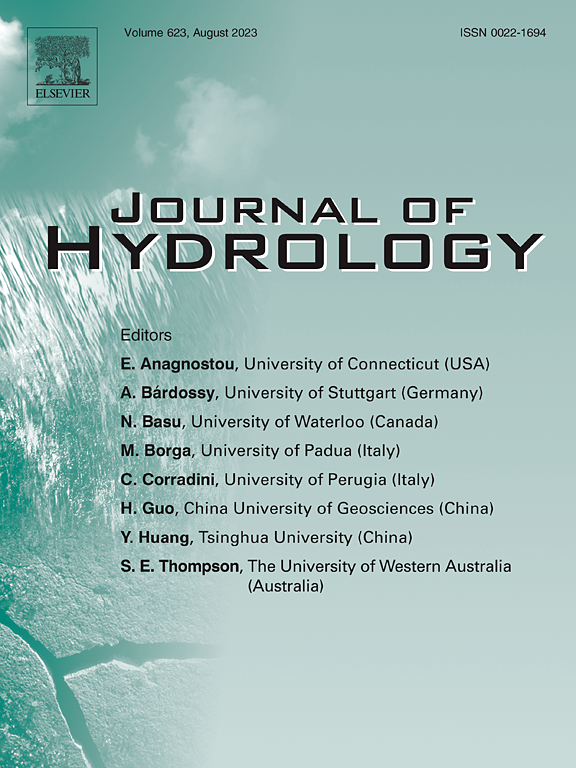Investigating the drought propagation dynamics between meteorological and groundwater drought in the Yellow River Basin, China
IF 5.9
1区 地球科学
Q1 ENGINEERING, CIVIL
引用次数: 0
Abstract
Understanding the mechanisms and propagation relationships between meteorological and groundwater droughts is crucial for producing early warnings of future hydrological droughts and groundwater management. However, scant research exists for mechanism of this unseen groundwater drought propagation. The drought characteristics and seasonal effects of meteorological drought and groundwater drought in the Yellow River Basin (YRB) were delved, based on the Standardized Precipitation Evapotranspiration Index (SPEI) and Groundwater Drought Index (GDI). Considering the problem of traditional drought propagation methods is not comprehensive, the modified drought propagation method was proposed, from both linear and nonlinear perspectives concerning their relationship. The findings indicate varying degrees of declining trends in meteorological and groundwater drought (slope = -0.0004/m, P < 0.01; slope = -0.0089/m, P < 0.01) in the YRB. The spatial distribution of worsening drought conditions is primarily concentrated in the central northern part of the YRB. However, groundwater drought has a larger affected area and a stronger declining trend. In terms of drought characteristics, meteorological and groundwater droughts have distinct seasonal patterns, but other characteristics show notable spatial heterogeneity. Meteorological droughts tend to occur early, have a high frequency, low intensity, and short duration. On the other hand, groundwater droughts exhibit opposite characteristics, occurring late, having a low frequency, high intensity, and long duration. The propagation time from meteorological drought to groundwater drought, calculated using linear and nonlinear methods, showed consistent seasonal effects, with the longest propagation time in winter and the shortest in summer. However, there are differences between the linear and nonlinear methods, with the linear method showing longer propagation times (12 months) compared to the shorter times in the nonlinear method (6 months). As for the characteristics of drought propagation, the modified drought propagation characteristic method proposed in this study demonstrates higher sensitivity and propagation rates compared to traditional single linear or nonlinear methods in the YRB. It compensates for the underestimation of traditional methods, providing better compensation and reducing uncertainty in the southern part of the YRB.
黄河流域气象干旱与地下水干旱间干旱传播动态研究
了解气象干旱和地下水干旱之间的机制和传播关系对未来水文干旱和地下水管理的早期预警至关重要。然而,对这种看不见的地下水干旱传播机制的研究却很少。基于标准化降水蒸散指数(SPEI)和地下水干旱指数(GDI),研究了黄河流域气象干旱和地下水干旱的干旱特征及季节效应。针对传统干旱繁殖方法存在的不全面的问题,从线性和非线性两方面考虑二者之间的关系,提出了改进的干旱繁殖方法。结果表明,气象和地下水干旱有不同程度的下降趋势(斜率= -0.0004/m, P <;0.01;斜率= -0.0089/m, P <;0.01)。旱情恶化的空间分布主要集中在长江三角洲中北部。而地下水干旱的影响范围更大,下降趋势更强。在干旱特征上,气象干旱和地下水干旱具有明显的季节特征,但其他特征表现出显著的空间异质性。气象干旱发生早、频率高、强度低、持续时间短。另一方面,地下水干旱表现出相反的特征,发生时间晚、频率低、强度大、持续时间长。采用线性和非线性方法计算气象干旱对地下水干旱的传播时间,其季节效应一致,冬季传播时间最长,夏季传播时间最短。然而,线性和非线性方法之间存在差异,线性方法的传播时间较长(12个月),而非线性方法的传播时间较短(6个月)。在干旱繁殖特性方面,本文提出的改进的干旱繁殖特性方法比传统的单一线性或非线性方法具有更高的敏感性和繁殖率。它弥补了传统方法的低估,提供了更好的补偿,减少了YRB南部的不确定性。
本文章由计算机程序翻译,如有差异,请以英文原文为准。
求助全文
约1分钟内获得全文
求助全文
来源期刊

Journal of Hydrology
地学-地球科学综合
CiteScore
11.00
自引率
12.50%
发文量
1309
审稿时长
7.5 months
期刊介绍:
The Journal of Hydrology publishes original research papers and comprehensive reviews in all the subfields of the hydrological sciences including water based management and policy issues that impact on economics and society. These comprise, but are not limited to the physical, chemical, biogeochemical, stochastic and systems aspects of surface and groundwater hydrology, hydrometeorology and hydrogeology. Relevant topics incorporating the insights and methodologies of disciplines such as climatology, water resource systems, hydraulics, agrohydrology, geomorphology, soil science, instrumentation and remote sensing, civil and environmental engineering are included. Social science perspectives on hydrological problems such as resource and ecological economics, environmental sociology, psychology and behavioural science, management and policy analysis are also invited. Multi-and interdisciplinary analyses of hydrological problems are within scope. The science published in the Journal of Hydrology is relevant to catchment scales rather than exclusively to a local scale or site.
 求助内容:
求助内容: 应助结果提醒方式:
应助结果提醒方式:


